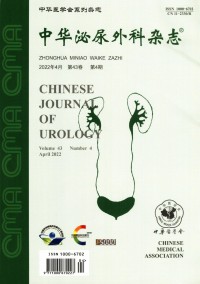Analysis of risk factors for recurrent urethral stricture after excision and primary anastomotic urethroplasty
Q4 Medicine
引用次数: 0
Abstract
Objective To analysis the risk factors for stricture recurrence after excision and primary anastomotic urethroplasty(EPA). Methods 209 urethral stricture cases managed with EPA were retrospectively studied from January 2017 to December 2018 in our center. Of all the patients, 183 cases were diagnosed as posterior urethral stricture and 26 cases were diagnosed as bulbar urethral stricture. Their age ranged from 5 to 78 years(mean 42.1 years). 25 cases(12.0%) were defined as the obesity, whose BMI was more than 28 kg/m2. 12 cases(5.7%) has the history of diabetes mellitus. 103 cases(49.3%) smoked at least three months before operation. 127 cases(60.8%) didn't have the history of dilation. 42 cases(20.1%)had the history of dilation once or twice. 40 cases (19.1%)had the history of dilation more than three times. The history of urethroplasty included once in 38 cases(18.2%)and more than twice in 8 cases(3.8%). The location of stricture included posterior urethral stricture in 183 cases and bulbar stricture in 26 cases. The history of stricture ranged from 1 to 360 months(mean 35.1 months). The stricture length was(3.19±0.65)cm. The causes including trauma in 190 cases, iatrogenic urethral injury in 12 cases, inflammatory in 2 cases and others in 5 cases. The standard of stricture recurrence were defined as the urination difficulty after removal of catheter and endoscopic or radiographic evidence of obstruction in the area of repair. Univariate and multivariate analysis were performed by the use of Cox′s proportional hazards regression model to identify the related factors for stricture recurrence. Result The following up period was ranged from 3 to 32 months(average 18.78 months). Recurrence occurred in 31 cases in the period of 1.0 to 18.0 months(average 5.34 months). Factors had statistical differences in univariate analysis including stricture period(HR=1.007, P<0.001), stricture length(HR=5.334, P<0.001), history of direct vision internal urethrotomy (DVIU)(HR=2.901, P=0.003), history of urethral dilation ≥3 times(HR=6.214, P<0.001), history of urethroplasty 1 time, ≥2 times(HR=4.175, P=0.001, HR=9.885, P<0.001), 3 months smoking before surgery(HR=2.605, P=0.016), suprapubic cystostomy(HR=0.231, P=0.006), inferior pubectomy(HR=6.603, P<0.001). In multivariate analysis stricture length(HR=4.911, P<0.001), history of urethroplasty 1 time, ≥2 times(HR=2.387, P=0.045, HR=3.688, P=0.015), 3 months smoking before surgery(HR=2.730, P=0.030)were independent risk factors. Conclusion The urethral stricture recurrence mainly occurred within 6 months after surgery. The length of stricture, history of urethroplasty and 3 months smoking before surgery were the independent risk factors for stricture recurrence. Key words: Urethral stricture; Anastomotic urethroplasty; Stricture recurrence; Risk factors尿道切除术及一期吻合口尿道成形术后复发性尿道狭窄危险因素分析
目的分析原发性吻合口尿道成形术(EPA)术后狭窄复发的危险因素。方法回顾性分析2017年1月至2018年12月我院应用EPA治疗的209例尿道狭窄病例。其中183例诊断为后尿道狭窄,26例诊断为球尿道狭窄。年龄5 ~ 78岁,平均42.1岁。25例(12.0%)为肥胖,BMI大于28 kg/m2。12例(5.7%)有糖尿病病史。术前至少3个月吸烟103例(49.3%)。127例(60.8%)无扩张史。有1 ~ 2次扩张史42例(20.1%)。40例(19.1%)有3次以上扩张史。尿道成形术史1次38例(18.2%),2次以上8例(3.8%)。狭窄部位包括后尿道狭窄183例,球部狭窄26例。狭窄病史1 ~ 360个月,平均35.1个月。狭窄长度为(3.19±0.65)cm。病因包括外伤190例,医源性尿道损伤12例,炎症2例,其他5例。狭窄复发的标准定义为拔除导管后出现排尿困难,并有内窥镜或x线片证据表明修复区存在梗阻。采用Cox比例风险回归模型进行单因素和多因素分析,以确定狭窄复发的相关因素。结果随访3 ~ 32个月,平均18.78个月。31例复发,复发时间1.0 ~ 18.0个月,平均5.34个月。单因素分析差异有统计学意义的因素包括狭窄期(HR=1.007, P<0.001)、狭窄长度(HR=5.334, P<0.001)、直视内尿道切开术(DVIU)史(HR=2.901, P=0.003)、尿道扩张史≥3次(HR=6.214, P<0.001)、尿道成形术1次或≥2次(HR=4.175, P=0.001, HR=9.885, P<0.001)、术前吸烟3个月(HR=2.605, P=0.016)、耻骨上膀胱造口术(HR=0.231, P=0.006)、耻骨下切除术(HR=6.603, P<0.001)。多因素分析中,狭窄长度(HR=4.911, P<0.001)、1次、≥2次尿道成形术史(HR=2.387, P=0.045, HR=3.688, P=0.015)、术前3个月吸烟(HR=2.730, P=0.030)为独立危险因素。结论尿道狭窄复发主要发生在术后6个月内。狭窄长度、尿道成形术史和术前吸烟3个月是狭窄复发的独立危险因素。关键词:尿道狭窄;吻合的尿道成形术;狭窄复发;风险因素
本文章由计算机程序翻译,如有差异,请以英文原文为准。
求助全文
约1分钟内获得全文
求助全文
来源期刊

中华泌尿外科杂志
Medicine-Nephrology
CiteScore
0.10
自引率
0.00%
发文量
14180
期刊介绍:
Chinese Journal of Urology (monthly) was founded in 1980. It is a publicly issued academic journal supervised by the China Association for Science and Technology and sponsored by the Chinese Medical Association. It mainly publishes original research papers, reviews and comments in this field. This journal mainly reports on the latest scientific research results and clinical diagnosis and treatment experience in the professional field of urology at home and abroad, as well as basic theoretical research results closely related to clinical practice.
The journal has columns such as treatises, abstracts of treatises, experimental studies, case reports, experience exchanges, reviews, reviews, lectures, etc.
Chinese Journal of Urology has been included in well-known databases such as Peking University Journal (Chinese Journal of Humanities and Social Sciences), CSCD Chinese Science Citation Database Source Journal (including extended version), and also included in American Chemical Abstracts (CA). The journal has been rated as a quality journal by the Association for Science and Technology and as an excellent journal by the Chinese Medical Association.
 求助内容:
求助内容: 应助结果提醒方式:
应助结果提醒方式:


